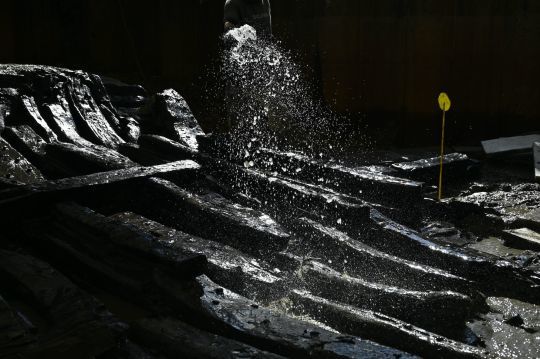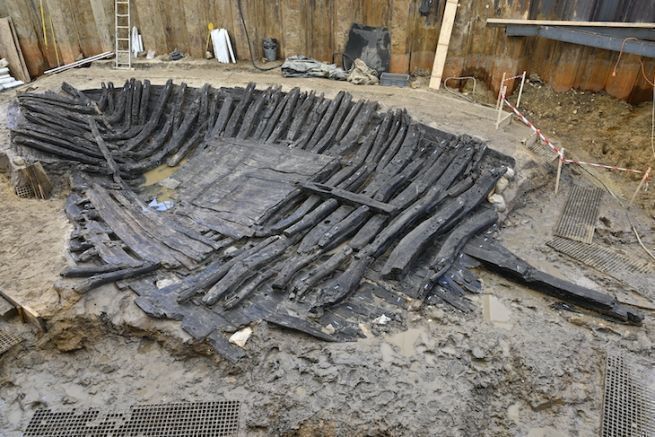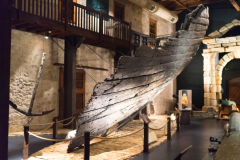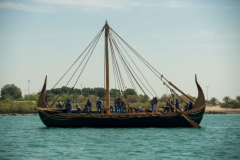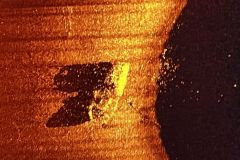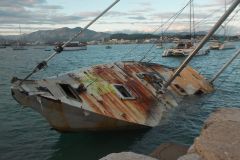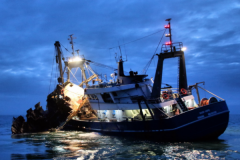A wreck from the Middle Ages dedicated to the transport of goods
It is a major discovery that a team of archaeologists from Inrap have just uncovered. This excavation, commissioned and financed by the State/DRAC of New Aquitaine, has uncovered a wreck buried in the wet sediments of the Estey du Lugan, a stream in Villenave-d'Ornon, on the banks of the Garonne. It is a robust boat, certainly for transporting goods, whose radiocarbon dating places its construction between the end of the VI e and the beginning of the VIII e century, i.e. the early Middle Ages. Ceramics dating back to the Middle Ages and found inside the boat confirm the dating of the boat. Dendrologists will also date certain pieces of wood.
The remains consist of a hull bottom with frames of 12 m long and the keel. The total length of the boat could be 15 m since the whole rear part is missing.
"Considering the number of frames, very tight with numerous and dense extensions, the load capacity of the boat had to be very important. The side and bottom rigging offers the possibility of transporting bulk cargo. Cereals and cultivated plants have also been found that could have been transported goods. It must be determined if they arrived afterwards or if they were present in the ship." explains Laurent Grimbert, in charge of the excavation.
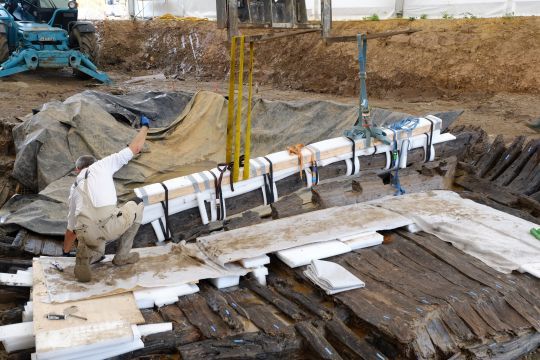

This cargo sailboat must have been able to sail on the Garonne, but also to make coastal navigation on the Atlantic coast. The wreck is in a good state of conservation and several types of wood could be detected, oak and softwood.
There are few clues about the rigging, although the imprint of the mast in the floor and the rigging should be able to restore the height. The rigging should be reconstructed during the wreck analysis phase.
If the stern of the wreck is missing, probably washed away by the tide and with an estimated length of 2 or 3 meters, there is no trace of perforation on the rest of the hull. The boat must have simply been abandoned or no longer maintained, before taking on water and sinking.
Analyze the construction method of medieval ships
The wreckage will be completely dismantled and documented thanks to photos, 3D restitution, topography and the different pieces of wood recorded. This complete dismantling will allow us to analyze the construction in detail and to determine the architectural tradition in which it fits. The excavations should also allow us to understand its environment and the reasons for its presence in this place. A small port near the mouth of a river running alongside the Garonne, in a marshy area exploited since Antiquity and throughout the medieval period, proves that the area was exploited for its resources.
If the data on navigation and construction methods of the Gallo-Roman years are quite numerous, this medieval period remains unknown.
"In France and for this type of cargo ship, and this period, it is a rare discovery. A second underwater wreck had been discovered in the Charente, the wreck of Port Berteau. It was upside down in the river, but the keel had not been preserved says Laurent Grimbert.

What will happen to the Euro wreck?
"We are only in charge of dismantling the wreck and carrying out the archaeological analysis. It is a major relic. However, some tracks are being studied for the future of the wreck." continues Laurent Grimbert.
Three solutions are being studied, from the least expensive to the most expensive. Once dismantled, the wreck can be reburied. A second solution consists in putting it in a basin outside to present it one day. Finally, it could be stored, in whole or in part, in a tank before being freeze-dried and exhibited in a museum. This last solution is the most expensive, because to preserve a wreck of this size is very expensive. Only some parts will be preserved and the rest reconstructed in facsimile.
In the meantime, the excavation, which should last until September 2022, is a kind of race against time since left in the open air, the wreckage is strongly degraded.
"If you leave it for three days without watering, it will degrade and you will lose a lot of elements. We leave it out of the water a lot to be able to work and we water it regularly to moisten it and avoid damage. It is a race against the clock", concludes the person in charge of the excavations.
